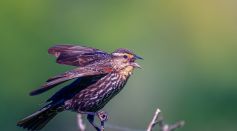ENVIRONMENT & CLIMATE

Bezos, Milner Fund Altos Labs on Anti-Aging Research; New Biological Reprogramming Start-up Focuses on Age Reversal

Starlings Vocalize More Than Initially Thought; Bird's Singing Ability Linked to Brain Development
Race Against Time To Trace Oil Spill Source in Gulf of Mexico, Was It Caused by Hurricane Ida?
Hurricane Larry Path Tracker: NASA Shares Image of Monster Category-3 Typhoon As It Approaches Bermuda, US, Atlantic
Ant Teeth: Scientists Reveal How They Can Help in the Development of Gadgets
Earth Evolution: Geologists Reveal This Planet Could Further Evolve into Massive Supercontinents in 200 Million Years

Air Filter Leader Filter King Summarizes Us Temperatures, and Which States Are the Hottest

Whale Watching, Ship Noise Cause Stress in Marine Animals; Cortisol in Water Spray Shows Physiological Stress
Mad Cow Diseases Identified in Brazil; 2 Unusual Cases Detected Causing the Suspension of Beef Exports to China

Dog Behavior: Study Reveals How Man's Best Friend Can Distinguish Humans' Intentional Acts From Unintentional Ones
Komodo Dragons Now Listed as ‘Endangered’; IUCN Red List Warns Threat of 2-in-5 Shark Extinction
Tibetan Plateau Ice-Covered Lakes Influencing Heat Transfer in Land, Atmosphere

Supervolcanoes Still Active, Hazardous After Massive Eruptions Thousands of Years Ago
Parasitic Cookiecutter Sharks Terrorize Not Only Great White Sharks, Whales, but Animals of All Sizes in Varying Ocean Depths
Most Popular

Jeff Bezos' Vision of Millions Living in Space Nears Reality After Blue Origin Rocket Breakthrough

Hepatitis Types Explained: How to Recognize Hepatitis A, B & C Symptoms and Protect Your Liver

Microplastics Health Effects: Are Environmental Toxins and Plastic in the Bloodstream Dangerous?

3I/ATLAS: The Truth Behind the Mysterious Interstellar Object Now Targeted by NASA and UN Teams




